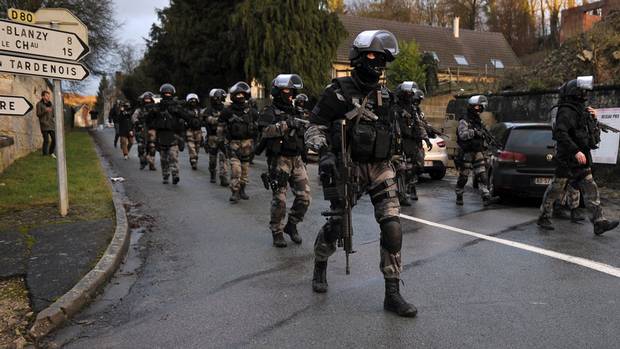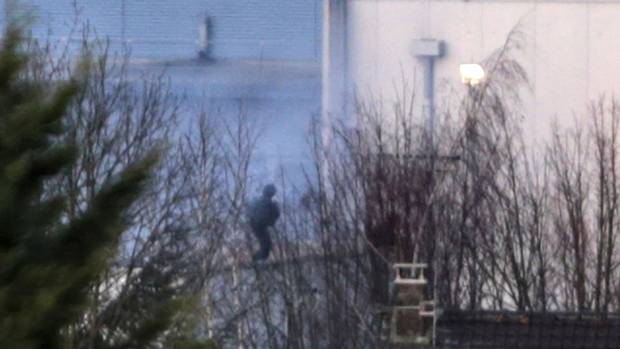DAY 1
1. At 11:28 a.m. on Jan. 7, the satirical French weekly magazine Charlie Hebdo tweets a cartoon mocking Abu Bakr al-Baghdadi, the leader of Islamic State. Here's Tu Thanh Ha and Joanna Slater's explanation of Charlie Hebdo's controversial past and previous attacks on the magazine.
Meilleurs vœux, au fait. pic.twitter.com/a2JOhqJZJM
— Charlie Hebdo (@Charlie_Hebdo_) January 7, 20152. Two black-clad armed men get out of a black Citroen and enter 6 rue Nicolas Appert. They are looking for the Charlie Hebdo offices, but have reached the wrong address. According to a letter carrier interviewed by French media, the men questioned her about where Charlie Hebdo was, then "fired a few shots to scare us."
Amateur video shows the gunmen fleeing the Charlie Hebdo office on Jan. 7, 2015.
REUTERS TV/REUTERS
3. The gunmen enter the correct address down the street, shooting at two maintenance workers after asking them where Charlie Hebdo's offices were. The gunmen find a Charlie Hebdo cartoonist, Corinne Rey – who had just picked up her daughter at daycare – and threaten her until she leads them to the office.
4. The gunmen burst into the Charlie Hebdo conference room during its weekly editorial meeting, asking for the cartoonists by name before shooting at them. "It lasted five minutes … I hid under a desk," Ms. Rey tells French media. (Read more about the victims here.)
The dead included cartoonists Charb, Wolinski, Cabu and Tignous and deputy chief editor Bernard Maris.
AFP/GETTY IMAGES
5. The gunmen flee the office, firing on police as they make a getaway. The men get out of their vehicles and engage more police officers in a gunfight.
Raw footage captures gunfire on street outside Paris newspaper
0:52
6. Ahmed Merabet, a Muslim police officer, is shot in the head by the gunmen as he lies wounded on the sidewalk. (His death would inspire the #JeSuisAhmed solidarity protests on social media in the days to come.)
7. The gunmen's Citroen crashes into a car and the gunmen abandon it, hijacking a Renault Clio. A manhunt begins for the Clio and the three suspects.
8. French police release photos of two suspects, the brothers Said and Chérif Kouachi. Here's Tu Thanh Ha's explanation of the Kouachis' militant pedigree and their ties to the other attackers.
Chérif and Said Kouachi are shown in photos provided by the Paris Police Prefecture on Jan. 8, 2015.
ASSOCIATED PRESS
9. Parisians mourn the Charlie Hebdo victims by holding up pencils, pens, markers and other writing implements in the air at impromptu demonstrations.
10. At dusk, thousands of Parisians gather at Place de la République at the statue of Marianne, the mythical woman symbolizing the French nation. Crowds chant "we are Charlie!" as the hashtag #JeSuisCharlie trends around the world.
People gather in Paris on Jan. 7, 2015.
THIBAULT CAMUS/ASSOCIATED PRESS
11. Cartoonists around the world pay tribute to the victims. Here's what The Globe's Brian Gable came up with.
The Globe’s editorial cartoonist discusses the importance of free speech and satire
2:51
DAY 2
12. The next morning, the attack on Paris is front-page news across the globe. Here's how some major dailies covered the event.
13. Explosions hit near two French mosques overnight and early in the morning, raising fears of anti-Muslim reprisals.
14. Parisians wake up under heightened security as the manhunt for the suspects continues. Here's what Parisian Monica Casali told The Globe about how life went on the next day.
From riding the metro to dropping off kids, life has changed in our city: Paris resident
2:07
15. With helicopters overhead, police pursue the Kouachi brothers in the city's north after a report that two men resembling them robbed a gas station.

French police special forces walk in Corcy, northern France, on January 8, 2015 as they carry out searches.
AFP/GETTY IMAGES
16. Paris observes a national day of mourning. The rector of the Paris Mosque, Dalil Boubakeur, urges Muslims to observe the moment of silence and calls on imams to address the tragedy in their Friday prayers the next day.
French Muslims pray at the mosque in Gennevilliers, a suburb north of Paris, on Jan. 8, 2015.
MAYA VIDON-WHITE FOR THE GLOBE AND MAIL
17. Stephen Harper, then Canada's prime minister, says "the international jihadist movement has declared war" and adds that the government would introduce unspecified new security measures. Here's Mark MacKinnon and Joanna Slater's analysis of the delicate balance between democracy and security in the immediate aftermath of the Paris attacks.
18. After observing the moment of silence at one minute past noon, legislators in France's National Assembly and Senate break out singing the French national anthem, La Marseillaise.
19. A Paris policewoman, Clarissa Jean-Philippe, is shot and killed while investigating a car crash involving a Renault Clio. The shooter is later identified as Amedy Coulibaly, one of the Kouachi's co-conspirators.
Police officers, firefighters and rescue workers gather at the site of a shooting on the morning of Jan. 8, 2015, in Montrouge, south of Paris.
KENZO TRIBOUILLARD/AFP/GETTY IMAGES
20. The Eiffel Tower goes dark in memory of the Paris victims.
Lights out at the Eiffel Tower
0:38
DAY 3
21. Police close in on the Kouachis, who flee in a stolen car in a high-speed chase down the A2 motorway.
22. The Kouachis end up in Dammartin-en-Goële, about 13 kilometres from Charles de Gaulle airport, and storm a printing building, taking a hostage.

French commandos launch an assault as smoke rises from a building in Dammartin-en-Goele, northeast of Paris, on Jan. 9, 2015.
23. Meanwhile in Paris, Mr. Coulibaly, armed with an automatic rifle, attacks a kosher grocery store in the eastern Porte de Vincennes, taking hostages. Here's what The Globe's Mark MacKinnon saw at the scene.
Mark MacKinnon on the ground in Paris
0:57
24. The Porte de Vincennes hostage-taking throws downtown Paris into disarray in a neighbourhood usually crowded with shoppers for the Jewish Sabbath. Paris officials close the shops along Rosiers Street in the city's famed Marais neighbourhood.
25. While in lockdown, pupils at a Dammmartin-en-Goële middle school briefly open the metal shutters on the windows to chant "Charlie, Charlie" at the media and police.
26. Police storm the printing plant, freeing the hostage and killing the Kouachi brothers.
27. Special-forces troops throw flash grenades and raid the kosher grocery store in a firefight that left Mr. Coulibaly and four hostages dead, and 15 hostages freed.
A screengrab taken from an AFP TV video shows French police special forces launching the assault at a kosher grocery store in Porte de Vincennes, Paris
GABRIELLE CHATELAIN/AFP/GETTY IMAGES
28. A manhunt begins for Mr. Coulibaly's common-law wife, Hayat Boumeddiene, who police allege was his accomplice. She is still at large.
Hayat Boumeddiene and Amedy Coulibaly are shown in photos released by French police.
AFP/GETTY IMAGES
29. Charlie Hebdo is named an honorary citizen of Paris as financial support pours in from the government and foreign media.
30. In a televised address, French President François Hollande warns that the danger to France has not yet passed. "These madmen, fanatics, have nothing to do with the Muslim religion," Mr. Hollande said in a televised address. "France has not seen the end of the threats it faces."
EPILOGUE: HOW FRANCE REMEMBERS THE ATTACKS
This week, French President François Hollande honoured the 17 victims by unveiling plaques around Paris marking violence that ushered in a tumultuous year.
Meanwhile, Charlie Hebdo's 32-page anniversary edition – which bore a front-page caricature of a bloody God wielding an assault rifle – accused Islamic fundamentalists, organized religion, an irresolute government and intelligence failures for last year's violence in France, which included the Nov. 13 carnage in Paris that killed 130 people.
The special commemorative edition of Charlie Hebdo is shown at a Paris newsstand in Paris.
JACQUES DEMARTHON/AFP/GETTY IMAGES
With reports from Mark MacKinnon, Tu Thanh Ha, Joanna Slater, Les Perreaux, Steven Chase, Reuters, Associated Press and The Canadian Press

